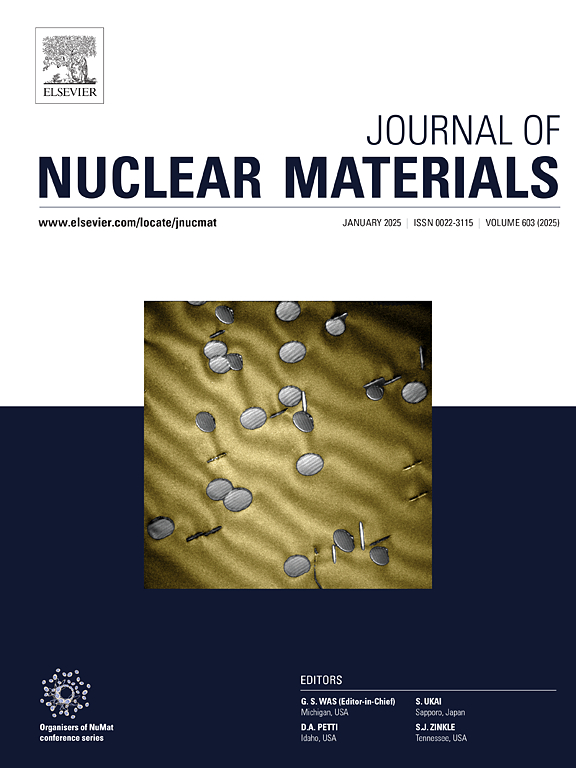Stress-induced corrosion behavior of martensitic P91 steel in high-temperature and high-pressure supercritical carbon dioxide for brayton cycle system
IF 3.2
2区 工程技术
Q3 MATERIALS SCIENCE, MULTIDISCIPLINARY
引用次数: 0
Abstract
The corrosion behavior of alloy materials employed in high-temperature components of supercritical carbon dioxide (S-CO2) Brayton cycle power generation systems is a critical factor influencing both the efficiency and service life of the system. In this study, we investigated the corrosion behavior of martensitic P91 steel exposed to S-CO2 at 550 °C and 20 MPa for up to 1000 h. The effect of stress loading (0/210/420 MPa) on the corrosion behavior was studied using a four-point bending stress loading device. The results revealed that the surface of the specimen exhibited extensive corrosion areas, indicating that the corrosion type of martensitic P91 was uniform corrosion rather than localized corrosion. In addition, the corrosion layer on the surface displayed a carbon deposition phenomenon, which differs from the metal corrosion typically observed in conventional steam cycles. The thickness of the corrosion product layer on the specimen surface under three conditions were 15.6 μm, 17.6 μm, and 27 μm, respectively. All corrosion layers exhibited a double-layer structure, with the outer layer primarily composed of Fe3O4 and the inner layer mainly consisting of FeCr2O4 and Fe2SiO4. This indicates that stress loading has minimal impact on the phase composition of the corrosion products, but it accelerates the corrosion rate of the steel, increasing the thickness of the oxide layer. Additionally, the oxide layer thickness increases with rising stress values, accompanied by localized spalling.
马氏体P91钢在高温高压超临界二氧化碳布雷顿循环系统中的应力致腐蚀行为
超临界二氧化碳(S-CO2)布雷顿循环发电系统高温部件中合金材料的腐蚀行为是影响系统效率和使用寿命的关键因素。在这项研究中,我们研究了马氏体P91钢在550°C和20 MPa的S-CO2中暴露长达1000小时的腐蚀行为。使用四点弯曲应力加载装置研究了应力加载(0/210/420 MPa)对腐蚀行为的影响。结果表明,试样表面出现大面积的腐蚀区域,表明马氏体P91的腐蚀类型为均匀腐蚀而非局部腐蚀。此外,表面腐蚀层表现出碳沉积现象,这与传统蒸汽循环中观察到的金属腐蚀不同。三种腐蚀条件下试样表面腐蚀产物层厚度分别为15.6 μm、17.6 μm和27 μm。腐蚀层均呈双层结构,外层主要由Fe3O4组成,内层主要由FeCr2O4和Fe2SiO4组成。这表明应力加载对腐蚀产物相组成的影响很小,但它加速了钢的腐蚀速度,增加了氧化层的厚度。此外,氧化层厚度随应力值的增加而增加,并伴有局部剥落。
本文章由计算机程序翻译,如有差异,请以英文原文为准。
求助全文
约1分钟内获得全文
求助全文
来源期刊

Journal of Nuclear Materials
工程技术-材料科学:综合
CiteScore
5.70
自引率
25.80%
发文量
601
审稿时长
63 days
期刊介绍:
The Journal of Nuclear Materials publishes high quality papers in materials research for nuclear applications, primarily fission reactors, fusion reactors, and similar environments including radiation areas of charged particle accelerators. Both original research and critical review papers covering experimental, theoretical, and computational aspects of either fundamental or applied nature are welcome.
The breadth of the field is such that a wide range of processes and properties in the field of materials science and engineering is of interest to the readership, spanning atom-scale processes, microstructures, thermodynamics, mechanical properties, physical properties, and corrosion, for example.
Topics covered by JNM
Fission reactor materials, including fuels, cladding, core structures, pressure vessels, coolant interactions with materials, moderator and control components, fission product behavior.
Materials aspects of the entire fuel cycle.
Materials aspects of the actinides and their compounds.
Performance of nuclear waste materials; materials aspects of the immobilization of wastes.
Fusion reactor materials, including first walls, blankets, insulators and magnets.
Neutron and charged particle radiation effects in materials, including defects, transmutations, microstructures, phase changes and macroscopic properties.
Interaction of plasmas, ion beams, electron beams and electromagnetic radiation with materials relevant to nuclear systems.
 求助内容:
求助内容: 应助结果提醒方式:
应助结果提醒方式:


